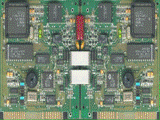Electrical and Computer Engineering, Department of
Document Type
Article
Date of this Version
2011
Citation
2011 7th International Wireless Communications and Mobile Computing Conference (IWCMC), doi: 10.1109/IWCMC.2011.5982549
Abstract
The North American freight railroad industry is trying to leverage wireless sensor networks (WSN) onboard railcars for advanced monitoring and alerting. In railroad environments, freight train WSNs exhibit a linear chain-like topology of significant length. Thus, existing wireless technologies such as the IEEE 802.15.4 communication protocol, based on a star topology, are unable to provide reliable service. The end-to-end communication between nodes generally relies on individual nodes communicating with their respective neighbors to carry the information over multiple hops and deliver it to the preferred destination. The routing performance and reliability significantly degrades with increasing number of hops. We proposed a multitier multi-hop network which is designed to overcome these issues in large-scale multi-hop WSNs in railroad environments. This approach has significant advantages, such as more data bandwidth, higher reliability, and lower energy consumption. Our analytical results show that the proposed multi-tier communication approach spends energy more efficiently and utilizes less resource than the traditional chain topology on board freight trains.



Comments
Copyright IEEE 2011. Used by permission.